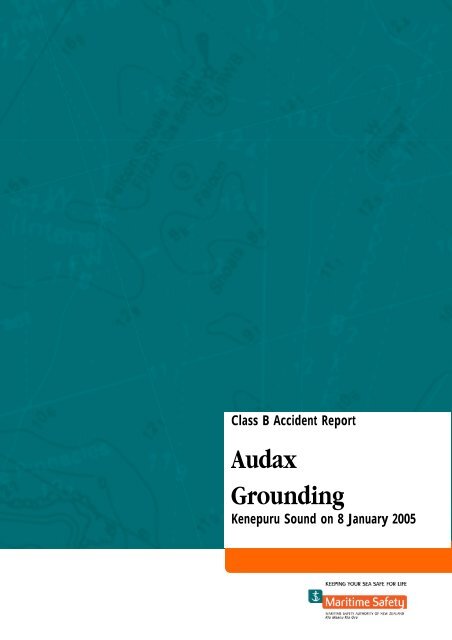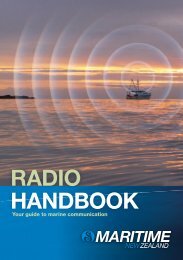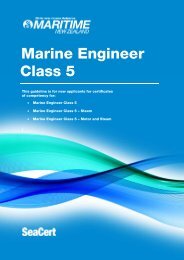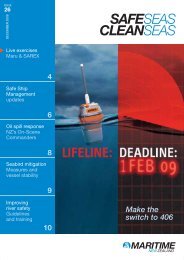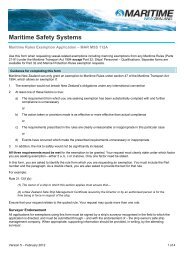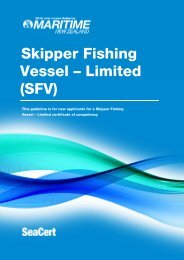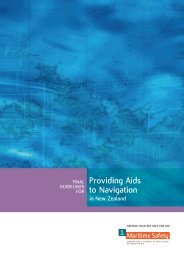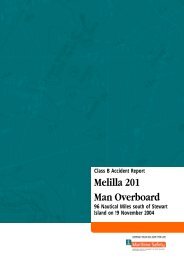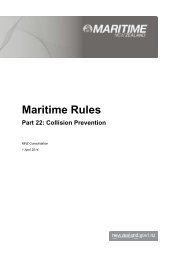Class B Accident Report Audax Grounding - Maritime New Zealand
Class B Accident Report Audax Grounding - Maritime New Zealand
Class B Accident Report Audax Grounding - Maritime New Zealand
You also want an ePaper? Increase the reach of your titles
YUMPU automatically turns print PDFs into web optimized ePapers that Google loves.
<strong>Class</strong> B <strong>Accident</strong> <strong>Report</strong><br />
<strong>Audax</strong><br />
<strong>Grounding</strong><br />
Kenepuru Sound on 8 January 2005
REPORT NO: 05 1168<br />
AUDAX<br />
GROUNDING<br />
<strong>Audax</strong> grounded in Kenepuru Sound whilst transiting from Portage Bay to Double<br />
Beach at about 0020 hours, <strong>New</strong> <strong>Zealand</strong> Daylight Time (NZDT), on 8 January<br />
2005. Onboard were the Skipper, his wife, their two sons and a friend of one of the<br />
sons.<br />
<strong>Audax</strong> hit the rocky shoreline at approximately 15-20 knots, narrowly missing the<br />
sheer cliffs to starboard and a potentially disastrous outcome. The vessel ended up<br />
almost completely out of the water. The passengers had to be evacuated by another<br />
vessel and taken back to their bach. <strong>Audax</strong> was re-floated on the high tide the next<br />
day. None of the family sustained any injuries but the vessel was badly damaged.<br />
APPROXIMATE TRACK AND POSITION OF GROUNDING<br />
<strong>Maritime</strong> Safety Authority <strong>Accident</strong> Investigation <strong>Report</strong><br />
2
Details of Vessels, Owner & Management, <strong>Class</strong>ification,<br />
Navigational Equipment, Manning & Crew:<br />
Name of Vessel:<br />
Vessel Type:<br />
<strong>Audax</strong><br />
Recreational<br />
Riviera <strong>Class</strong><br />
Built: 1993<br />
Construction Material:<br />
Glass reinforced plastic (GRP)<br />
Length Overall (m): 12.5m<br />
Propulsion:<br />
<strong>Accident</strong> Investigator:<br />
Twin Caterpillar engines - 240 kW<br />
Top speed about 25 knots<br />
Cruising speed 20 knots<br />
Zoe Brangwin<br />
• Owner/Skipper Details<br />
The Skipper has owned <strong>Audax</strong> for about nine years and has over 20 years<br />
experience owning and driving recreational vessels. He is also involved<br />
professionally in the maritime industry.<br />
The Skipper takes <strong>Audax</strong> out on a regular basis throughout the year and for at<br />
least a month every summer.<br />
At the time of the accident, the Skipper and his family were staying at their bach<br />
in Kenepuru Sound, Marlborough Sounds.<br />
The Skipper does not hold any boating qualifications.<br />
• Navigational Equipment onboard <strong>Audax</strong><br />
‣ 24 nautical mile radar<br />
‣ Chart plotter<br />
‣ Echo sounder<br />
‣ VHF radio<br />
The VHF radio was operational at the time of the accident. However the chart<br />
plotter and echo sounder were not working.<br />
<strong>Maritime</strong> Safety Authority <strong>Accident</strong> Investigation <strong>Report</strong><br />
3
The radar was inoperable due to a fault in the scanner. The unit had been<br />
serviced but had again developed the same fault after being in use for a short<br />
time.<br />
The Skipper stated that he did not use any of the navigational equipment as it<br />
was only a short trip from Portage to Double Beach and he knew the area very<br />
well.<br />
The Skipper was navigating visually and using his local knowledge.<br />
<strong>Maritime</strong> Safety Authority <strong>Accident</strong> Investigation <strong>Report</strong><br />
4
NARRATIVE<br />
At around 1830 hours, on the evening of the 7 January 2005, the family arrived at<br />
Portage Bay. They attended a BBQ dinner for a boating event that had been held<br />
earlier on that day.<br />
Just after midnight the family left the BBQ in their vessel <strong>Audax</strong>. They left Portage<br />
Bay for their bach at Double Beach, a trip that usually took about 10 minutes.<br />
2 vessels at<br />
anchor<br />
Witness at<br />
anchor<br />
Weka Pt<br />
Portage<br />
Bay<br />
Actual track<br />
Intended track<br />
APPROXIMATE COURSES AND POSITIONS OF AUDAX<br />
The weather was clear, calm with a light breeze. It was described as a dark night<br />
with no moon.<br />
After rounding Weka Point the Skipper observed the port and starboard navigation<br />
sidelights of another vessel right ahead. The vessel appeared to be on a reciprocal<br />
course to <strong>Audax</strong>. The vessel also appeared to veer slightly to port and then back<br />
onto a reciprocal course again. The Skipper of <strong>Audax</strong> presumed that the vessel was<br />
heading to an anchorage position in Fern Dale Bay.<br />
<strong>Maritime</strong> Safety Authority <strong>Accident</strong> Investigation <strong>Report</strong><br />
5
As the Skipper tried to identify the intentions of the oncoming vessel he took the<br />
vessel out of autopilot and steered the vessel manually. He then altered course to<br />
starboard to avoid passing too close to the vessel.<br />
While the Skipper was concentrating on the oncoming vessel he lost his orientation<br />
in relation to his planned track. Too late he realised that he was standing into danger<br />
before reducing speed. As he reduced speed the shoreline appeared in the vessel’s<br />
lights ahead and they grounded.<br />
The Skipper stopped both engines and left the vessel in its current position. He<br />
ascertained that everyone was ok before calling a local operator for assistance. The<br />
vessel had a hole in the bow, below the water line and a crack above the waterline.<br />
The occupant of another vessel that was anchored close by witnessed the accident.<br />
He got in his dingy and rowed over to offer assistance but was told it was not<br />
needed. He also witnessed an altercation between father and son immediately after<br />
the accident.<br />
The local operator took all the passengers back to their bach while the Skipper<br />
stayed onboard to look after the vessel.<br />
When the local operator arrived at <strong>Audax</strong>, the two Skippers ascertained that the<br />
vessel that had been observed ahead of <strong>Audax</strong>, displaying port and starboard<br />
navigation sidelights was in fact at anchor off the Western headland of Long Bay.<br />
When the local operator had passed the anchored vessel on his way to <strong>Audax</strong>, he<br />
noticed that it was still exhibiting port and starboard navigation sidelights. Later,<br />
however, after ferrying the passengers back to Double Beach on his return, he noted<br />
that the vessel was no longer displaying any navigational lights. The unidentified<br />
vessel did not come to their assistance and weighed anchor at first light.<br />
The Skipper and local operator affected a temporary repair to the hole in the bow.<br />
They then backed <strong>Audax</strong> off the shore with the rising tide and returned the vessel to<br />
the jetty at Double Beach.<br />
The vessel has since been taken to Nelson for repairs.<br />
<strong>Maritime</strong> Safety Authority <strong>Accident</strong> Investigation <strong>Report</strong><br />
6
FINDINGS<br />
The witness stated that a family member onboard <strong>Audax</strong> accused the Skipper of<br />
being intoxicated at the time of the accident.<br />
The Skipper of <strong>Audax</strong> stated that he had consumed four small bottles of beer during<br />
the evening between 1930 and 0001 hours.<br />
In commenting on the draft report the Skipper of <strong>Audax</strong> stated:<br />
“We believe the witness referred to in the report as being nearby, has subsequently<br />
proven unqualified to make judgements or comments with regard to the events<br />
relating to the grounding, nor was he in a position to sight any other vessels<br />
anchored in or near the intended path of <strong>Audax</strong>. His willingness to make<br />
judgemental statements with regard to the state of the Skipper on <strong>Audax</strong> without<br />
actually speaking to him, then refusing to provide assistance when asked by a person<br />
on board, makes the credibility of this witness highly questionable.”<br />
The Investigator spoke to the Police at Havelock who advised that following<br />
enquiries made by the Police, it was ascertained that the Skipper of <strong>Audax</strong> and three<br />
others had apparently drunk about 1½ bottles of wine between them during the<br />
course of the evening.<br />
In commenting on the draft report, the witness stated that there were no vessels<br />
anchored near his vessel that were visible to him. The next morning, however, he<br />
found that there were two small craft anchored around the corner in a cove to the<br />
west.<br />
In commenting on the draft report the witness stated:<br />
“As a witness it was my observation that:<br />
• <strong>Audax</strong> passed within a few metres of my vessel (safely at anchor with anchor<br />
light illuminated - clearly a major accident was narrowly averted).<br />
• <strong>Audax</strong> hit the coast at full speed (as evidenced by the fact that the vessel<br />
ended up so far up the rocks - nearly completely out of the water).<br />
• <strong>Audax</strong> narrowly missed the sheer rocks (which almost certainly would have<br />
caused injury to passengers),<br />
• <strong>Audax</strong> was seriously damaged and had to undergo extensive repairs for some<br />
months at Nelson.”<br />
The witness stated that this near miss with his vessel had caused him considerable<br />
anxiety.<br />
<strong>Maritime</strong> Safety Authority <strong>Accident</strong> Investigation <strong>Report</strong><br />
7
Situational Awareness<br />
The Skipper suffered from a loss of situational awareness, which resulted in the<br />
grounding of the vessel. Situational awareness can be defined as the accurate<br />
perception of the factors and conditions affecting the vessel and crew during a<br />
specific time period.<br />
Causes and or symptoms of loss of situational awareness includes the following:<br />
a. Fixation or preoccupation*<br />
b. Perception based on faulty information processing<br />
b. Ambiguity<br />
c. Complacency/familiarity*<br />
e. Confusion*<br />
f. Distraction<br />
g. Fatigue<br />
g. Overload/underload<br />
h. Poor communication<br />
j. Failure to meet targets<br />
k. Improper procedures or departure from regulations *<br />
The Skipper of <strong>Audax</strong> displayed a number of the above characteristics prior to the<br />
accident. They have been marked with a *.<br />
The Skipper was fixated/preoccupied with what the other vessel was doing.<br />
He had done that trip many times and knew the area well. He was only minutes<br />
away from his jetty at the time of the accident.<br />
The Skipper was confused by the intentions of the other vessel.<br />
The Skipper of the other vessel later stated that he was indeed displaying the<br />
incorrect lights but turned them off and switched on the anchor light at about the<br />
same time as the accident occurred.<br />
Rule Breaches<br />
The Skipper failed to reduce to a safe speed when navigating close to the shore. He<br />
also failed to keep a proper look out.<br />
<strong>Maritime</strong> Rule Part 22.5 - Look-Out states:<br />
Every vessel must at all times maintain a proper look-out by sight and hearing as<br />
well as by all available means appropriate in the prevailing circumstances and<br />
conditions, so as to make a full appraisal of the situation and the risk of collision.<br />
<strong>Maritime</strong> Safety Authority <strong>Accident</strong> Investigation <strong>Report</strong><br />
8
<strong>Maritime</strong> Rule 22.6-Safe Speed states:<br />
“Every vessel must at all times proceed at a safe speed so that proper and effective<br />
action to avoid a collision can be taken and the vessel can be stopped within a<br />
distance appropriate to the prevailing circumstances and conditions.”<br />
In determining a safe speed, the following factors must be among those taken into<br />
account:<br />
(1) For all vessels<br />
(a) The state of visibility:<br />
(b) The traffic density, including concentrations of fishing vessels or any<br />
other vessels:<br />
(c) The manoeuvrability of the vessel, with special reference to stopping<br />
distance and turning ability in the prevailing conditions:<br />
(d) At night, the presence of background light such as from shore lights or<br />
from the back scatter of the vessel's own lights:<br />
(e) The state of wind, sea, and current, and the proximity of navigational<br />
hazards<br />
(f) The draught in relation to the available depth of water.<br />
(2) Additionally, for vessels with operational radar<br />
a. The characteristics, efficiency, and limitations of the radar equipment:<br />
b. Any constraints imposed by the radar range scale in use:<br />
c. The effect on radar detection of the sea state, weather, and other sources<br />
of interference:<br />
d. The possibility that small vessels, ice, and other floating objects may not<br />
be detected by radar at an adequate range:<br />
e. The number, location, and movement of vessels detected by radar:<br />
f. The more exact assessment of the visibility that may be possible when<br />
radar is used to determine the range of vessels or other objects in the<br />
vicinity.<br />
<strong>Maritime</strong> Safety Authority <strong>Accident</strong> Investigation <strong>Report</strong><br />
9
In commenting on the draft report the witness stated:<br />
“I still find it difficult to accept the report’s conclusion as to how the Skipper<br />
became disorientated. On the attached expanded chart, I have shown exactly where<br />
my boat was anchored, where the two small craft were anchored, and the intended<br />
track of <strong>Audax</strong>. I fail to see how any clear headed Skipper can make a deviation<br />
towards the coast at speed on a pitch dark night, irrespective of the inadequate<br />
lighting of other anchored boats.”<br />
Lights<br />
<strong>Maritime</strong> Rule Part 22.30 - Anchored Vessels<br />
(1) A vessel at anchor must exhibit where it can best be seen -<br />
(a) in the fore part, an all -round white light or one black ball; and<br />
(b another all-round white light at or near the stern at a lower level than<br />
the light in the fore part;<br />
BUT if the vessel is less than 50 metres in length it may exhibit an all –round<br />
white light where it can best be seen instead of the lights referred to in<br />
subparagraphs (a) and (b) of this paragraph.<br />
(3) A vessel of less than 7 metres in length at anchor, not in or near a narrow<br />
channel, fairway, anchorage, or where other vessels normally navigate, is not<br />
required to exhibit the light or shape prescribed for a vessel at anchor.<br />
The Marlborough District Council Navigation bylaws state:<br />
3.1 <strong>Report</strong>ing of <strong>Accident</strong>s, Collisions and Incidents<br />
(i) The master of any ship that:<br />
(a) has been involved in a collision with any ship or property that involves damage<br />
to that ship that affects or is likely to affect its seaworthiness or has been sunk or<br />
grounded or become stranded in any harbour within the region; or<br />
(b) by reason of accident, fire, defect or otherwise is in such a condition as to affect<br />
its safe navigation or to give rise to danger to any person, other ships or<br />
property;or<br />
(c) in any manner gives rise to an obstruction; or<br />
(d) causes damage to any navigation aid or structure or anything on that structure;<br />
Must, as well as complying with any accident reporting requirements of the<br />
<strong>Maritime</strong> Transport Act 1994, as soon as practicable report the occurrence to the<br />
Harbourmaster or Enforcement Officer and as soon as is practicable, but within 7<br />
<strong>Maritime</strong> Safety Authority <strong>Accident</strong> Investigation <strong>Report</strong><br />
10
days, provide the Harbourmaster or Enforcement Officer with full written details of<br />
the occurrence.<br />
5.4 Speed of Powered Pleasure Craft<br />
1. No person shall navigate a ship (including a ship towing someone or some<br />
object) at a proper speed exceeding 5 knots when:<br />
(a) Within 50 metres of any other ship, floating structure or person in the water;<br />
or<br />
(b) Within either 200 metres of the shore or of any structure;<br />
<strong>Maritime</strong> Transport Act Section 31 - Obligation to Notify All <strong>Accident</strong>s,<br />
Incidents, Etc.<br />
The Master of-<br />
a) any <strong>New</strong> <strong>Zealand</strong> Ship; or<br />
b) Any foreign ship in <strong>New</strong> <strong>Zealand</strong> waters-<br />
That is involved in a mishap that results in serious har to a person, an accident, or<br />
an incident, shall notify the mishap, accident, or incident to the authority as soon as<br />
practicable.<br />
The Skipper of <strong>Audax</strong> failed to notify the <strong>Maritime</strong> Safety Authority of the<br />
grounding, therefore breaching Section 31 of the <strong>Maritime</strong> Transport Act.<br />
In commenting on the draft report the Skipper of <strong>Audax</strong> stated:<br />
“The incident was reported to The Marlborough District Council Harbourmaster<br />
and the Police within 15 hours of the incident. The Harbourmaster was to send an<br />
incident report but the copy which was faxed to our bach number was illegible and<br />
he was asked to post a copy to my Christchurch address, but this was not received.<br />
Neither the Police nor the Harbourmaster made suggestion that the incident should<br />
be reported to MSA, in fact the Police suggested, they would notify MSA Picton of<br />
the incident, and as there we no injuries, had no further interest.<br />
I hold a copy of the Marlborough Sounds Safe Boat bulletin issued to all marina<br />
berth holders, whilst it covers many safety issues, there is no mention of reporting.<br />
Perhaps this is area where there is poor knowledge amongst the boating fraternity<br />
as a result of poor education by the various maritime safety bodies.”<br />
<strong>Maritime</strong> Safety Authority <strong>Accident</strong> Investigation <strong>Report</strong><br />
11
SAFETY RECOMMENDATIONS<br />
1. It is recommended that the Skipper of <strong>Audax</strong> be censured for failing to use all<br />
available means to ensure the safe navigation of his vessel and subsequently<br />
endangering life and property, and for failing to report the accident to the<br />
<strong>Maritime</strong> Safety Authority and the regional Harbourmaster within an adequate<br />
time frame.<br />
In commenting on the draft report the Skipper of <strong>Audax</strong> stated<br />
“As for failing to report this incident to MSA. This is a little known and poorly<br />
advertised rule, I now know of this requirement, but how many other<br />
recreational boat owners would know of this requirement, I dare say very few.”<br />
In response to this comment it is recommended that the Education and<br />
Communication Division of the MSA reassess their recreational boating<br />
campaign with regard to reporting recreational accidents.<br />
In commenting on the draft report the Skipper of <strong>Audax</strong> stated:<br />
“I see no censure or suggested action against the skipper(s) of the vessel(s)<br />
displaying incorrect or no lights, and being involved in creating the incident, as<br />
per your Rule Part 22.30 (3) and as a consequence, endangered the lives of<br />
others.”<br />
2. It is recommended that the Skipper of <strong>Audax</strong> sit the <strong>New</strong> <strong>Zealand</strong> Coastguard<br />
Boat Masters Course and provide a copy of the completion certificate to the<br />
<strong>Maritime</strong> Safety Authority by 8 May 2005.<br />
3. It is recommended that the Skipper of the other vessel be censured for failing to<br />
display the correct navigation lights.<br />
4. It is recommended that a copy of this report be sent to the Marlborough District<br />
Council Harbourmaster and the <strong>Maritime</strong> Safety Authority Education and<br />
Communication Division, to promulgate the importance of displaying the correct<br />
lights at anchor and when underway.<br />
<strong>Maritime</strong> Safety Authority <strong>Accident</strong> Investigation <strong>Report</strong><br />
12


